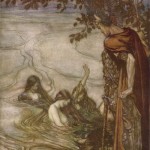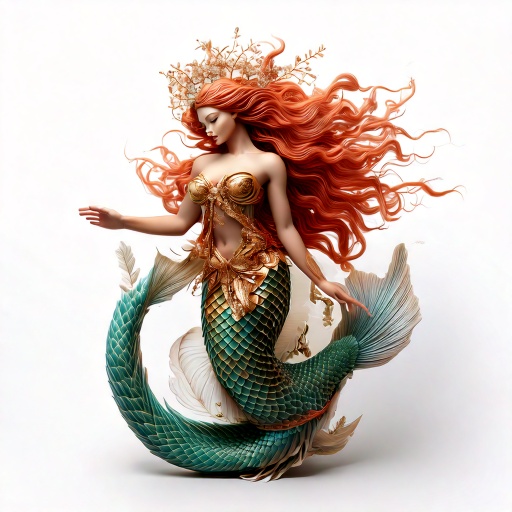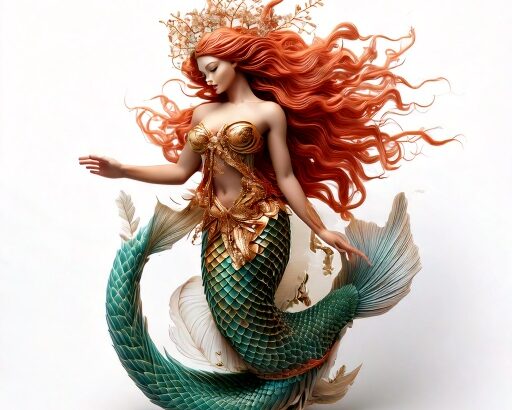Sprites, Naiads, and Nymphs: Exploring Water Spirits in Folklore and Mythology
Across ancient folklore and mythology, water sprites have fascinated cultures as mystical guardians of freshwater realms. Known by many names, they are most famously depicted in Greek mythology as Naiads, the nymphs of streams, rivers, and fountains. These beings were seen not just as protectors but as embodiments of the water’s life-giving and destructive powers. Often revered for their beauty and charm, they played pivotal roles in rituals, myths, and daily life, symbolizing the close bond between humanity and nature’s sacred waters. Whether inspiring ancient offerings or passing into cultural memory as alluring yet unpredictable figures, sprites like Naiads reveal humanity’s timeless respect for the elemental forces that sustain life.
Watch a related video on Naiads and their captivating myths
Understanding Water Sprites in Folklore
Water sprites are fascinating entities that have held a place in folklore for centuries. Representing the duality of water—both life-sustaining and treacherous—these supernatural spirits have captivated human imagination across cultures. Below, we’ll explore what water sprites are, how they’re perceived worldwide, and their symbolic importance in myths.
What Are Water Sprites?
Water sprites are mythical spirits tied to aquatic environments like rivers, lakes, and springs. Often described as ethereal and alluring, these beings are typically portrayed with enchanting beauty and a graceful demeanor. In folklore, sprites are often thought to be immortal, with a strong connection to nature that enables them to influence their surroundings.
While their appearances vary depending on the legend, they are generally regarded as protectors or guardians of water, embodying its purity and unpredictability. Some stories suggest that interacting with these spirits could lead to blessings, while others warn of dangerous, seductive qualities. This dual nature mirrors humanity’s experience with water itself—essential, yet capable of destruction.
For more information on their diverse appearances across myths, check this overview of water sprites and their cultural context.
Water Sprites Across Cultures
Water sprites feature prominently in stories from around the world, though they take on different names and characteristics depending on the region. Below are some notable examples:
- Slavic Folklore: Rusalkas are Slavic water spirits associated with lakes and rivers. These figures are often depicted as the restless souls of women who died near water, oscillating between protective and vengeful roles.
- Irish Mythology: Selkies, found in Celtic tales, are shapeshifting sea creatures that transform from seals into humans. These beings are deeply tied to themes of love, longing, and transformation.
- Japanese Legends: Japanese Kappas are water creatures that embody trickery and danger. Unlike the graceful sprites of Europe, Kappas are mischievous entities with a reptilian appearance.
Each iteration of water sprites reflects the broader cultural values and attitudes toward water, illustrating a universal recognition of its power. Read more about their cultural variations here: Water spirit across cultures.
Symbolic Significance of Water Sprites
Water sprites carry rich symbolic meanings that reveal humanity’s complex relationship with water. Purity is one of the most common associations, as these spirits are often linked to clear, life-giving springs and rivers. Many myths cast them as protectors of fertility, ensuring the well-being of crops, animals, and humans alike.
Interestingly, water sprites also embody danger and mystery. Their allure can lead people into treacherous waters or spiritual lessons. This tension between beauty and peril symbolizes the dual role water plays in human life as both a sustainer and destroyer.
These spirits also carry broader metaphysical implications, illustrating how water links the natural, human, and spiritual worlds. To gain a deeper understanding of their layered symbolism, visit this analysis of water sprites and cultural connections.
Water sprites, in their many forms, are a testament to the enduring connection between myth and the environment. By examining their stories, we glimpse how ancient cultures sought to explain and venerate the life-sustaining forces around them.

The Naiads: Freshwater Nymphs of Greek Mythology
In Greek mythology, Naiads are among the most enchanting figures, embodying the essence of freshwater sources. They’re more than mythical beings; they represent the vitality and perils of natural waters that sustain human existence. Their stories span across rivers, lakes, and springs, linking humanity’s relationship with freshwater to divine reverence.
Origins and Taxonomy of Naiads
The Naiads trace their lineage as daughters of the river gods, often springing from Oceanus, the primordial titan of the seas, or individual river deities. These freshwater nymphs were grouped by the specific bodies of water they governed, leading to classifications like:
- Limnades: Nymphs of lakes and marshes.
- Potameides: Guardians of rivers and streams.
- Pegaeae: Spirits of natural springs.
- Crinaeae: Protectors of small fountains and wells.
- Eleionomae: Nymphs linked to wetlands.
Their classification reflects the varied freshwater ecosystems they inhabited and safeguarded. Understanding this taxonomy helps in viewing how Greeks personified and honored their environment. Find more details on classifications here.
Roles and Attributes of Naiads
Naiads carried roles that extended beyond myth, deeply impacting how ancient Greeks viewed water. As guardians of freshwater sources, they were believed to maintain the vitality of the waters they embodied. Their attributes reflect their semi-divine nature:
- Beauty: Naiads were described as stunningly beautiful, akin to the pristine clarity of the waters they symbolized. Their allure played a significant role in mythological tales, often leading mortals and gods alike into their realm.
- Immortality: While they were ageless, their lives were intrinsically tied to the health of their waters. Polluted or dried-up sources could lead to their demise.
- Healing and Life-Giving Powers: Beyond their physical allure, the Naiads were also considered powerful healers. Their waters were thought to have restorative properties, making them essential to local rituals.
Their attributes cemented their place in both mythology and communal life. Learn more about their divine essence here.
Cultural Importance of Naiads in Greek Society
Naiads were not mere mythological entities; they held a profound place in ancient Greek life. Local communities worshiped them, attributing the health of their freshwater sources and agricultural prosperity to these nymphs. Offerings were made at their springs, particularly during droughts or agricultural festivals.
Their significance extended beyond worship into cultural expressions:
- Town Names: Many ancient Greek towns and cities were named after prominent Naiads, showcasing their esteem. For example, fountains like Arethusa were central to both myth and local identity.
- Art and Literature: Naiads were frequent subjects in sculptures and frescoes, appearing in flowing forms that mirrored the fluidity of water. Poets such as Hesiod and Homer celebrated their beauty and mystique.
Ultimately, the Naiads shaped a unique interplay between myth and ecology. Dive deeper into their cultural prominence by exploring this article.
Enchanting Yet Complex: Naiads’ Dual Nature
The Naiads’ portrayal in mythology goes beyond idealized beauty, dipping into complexity and contrast. They could be generous, offering blessings like fertility, good health, or even hero guidance. However, their connection to water’s volatility made them unpredictable and potentially dangerous.
Their duality stems from the reality of water itself: it sustains life but can also destroy it. Stories, such as those warning against wandering too close to streams at night, highlight this peril. Naiads, while enchanting, were known to drown those who polluted their waters or arrogance that led them to trespass sacred boundaries.
This dual nature made Naiads a vivid symbol of water’s dichotomy—life-giving and life-taking, depending on how humans interacted with it. For more on their intricate character, read this piece.
Each story and attribute of the Naiads weaves together threads of admiration, respect, and caution. Their enduring presence in Greek mythology underscores the ancients’ acknowledgment of water’s invaluable, yet paradoxical, role in life.
Comparison with Other Water Spirits in Greek Mythology
Greek mythology presents a rich tapestry of deities and spirits, with water nymphs forming a captivating subset. Among them, Naiads, Nereids, and Oceanids stand out as prominent water-associated figures, each with distinct roles and habitats. Understanding their differences and examining their connections to river gods, the Potamoi, sheds light on the depth of ancient Greek beliefs.
Naiads versus Nereids and Oceanids: Distinctions in Habitat, Roles, and Mythology
Naiads, Nereids, and Oceanids are collectively categorized as water nymphs, yet their habitats and mythological narratives set them apart. Each spirit is tied to a specific type of aquatic environment, reflecting the Greeks’ nuanced relationship with water.
- Habitats:
- Naiads: These spirits presided over freshwater sources such as springs, rivers, lakes, and fountains. Their existence was deeply tied to the vitality of their waters; a dried-up spring could signify the demise of its Naiad.
- Nereids: Dwelling in the Mediterranean Sea, Nereids represented the guardianship and fertility of the ocean. They were seen as benevolent spirits aiding sailors and calming storms, highlighting the Greeks’ reliance on the sea for trade and travel.
- Oceanids: Oceanids hailed from the vast, primordial ocean, embodying its boundlessness and mystery. They were often considered daughters of Oceanus and Tethys, pivotal figures in Greek cosmology.
- Roles in Myths:
- Naiads often acted as intermediaries, facilitating interactions between mortals and the divine. In some cases, they were known for their influence on fertility and well-being, especially in agricultural contexts.
- Nereids were celebrated for aiding heroes in great adventures, such as Thetis’ role as mother to Achilles or Galatea’s enduring mythology.
- Oceanids, like Styx, the spirit of a boundary river, symbolized deeper, universal allegories linked to the cosmos and oaths between gods.
- Cultural Depictions: Naiads were often depicted as serene yet mischievous figures connected to their local environment. On the other hand, Nereids exuded a serene elegance reflective of maritime beauty, while Oceanids presented a more ethereal, celestial quality.
Their distinctions emphasize the Greeks’ recognition of both the specific and universal significance of water. For further exploration of how nymphs like Naiads, Nereids, and Oceanids intertwine in mythology, read this comprehensive guide to water nymphs in Greek mythology.
Connections to the Potamoi: Familial and Symbolic Relationships
Naiads are frequently described as the daughters of the Potamoi, river gods who personified individual rivers in Greek mythology. These familial ties deepen the symbolic relationship between water nymphs and Greek natural landscapes.
The Potamoi themselves were divine sons of Oceanus and Tethys, positioning them as central figures within the aquatic pantheon. Each Potamos governed a specific river, granting it spiritual significance. Examples include Achelous, considered the largest river of Greece, and Scamander, closely tied to the Trojan War.
- Symbolic Connections:
- Naiads, as progeny of the Potamoi, represented the life-giving potential of rivers. Their presence symbolized the continuation of life, fertility, and abundance.
- In myths, these familial links often underscored the interconnectedness of waterways, reflecting how rivers nourished distant lands and unified civilizations.
- The protective qualities of the Naiads were seen as inherited traits, passed on from their Potamoi fathers who embodied the strength and vitality of rivers.
- Cultural Worship: The Potamoi and their Naiad daughters were frequently revered in local practices. Rituals involving offerings at riverbanks sought to appease these spirits, ensuring bountiful harvests and water clarity.
These nymphs’ direct ties to living waterways mirrored the Greeks’ dependency on rivers for agriculture, trade, and sustenance. Ancient Greeks saw rivers and their spirits as both nurturing and temperamental, a delicate balance that had to be respected. Learn more about the Potamoi and their roles as river gods here.
Naiads’ link to the Potamoi and their differences from other nymphs reflect a broader narrative about the natural environment’s spiritual significance in ancient Greece. This contrast and symbolism forge a vivid picture of how water spirits encapsulate both mythology and ecology.
Water Sprites in Modern Interpretations
Water sprites continue to captivate the imagination, evolving beyond folklore and becoming symbols of nature, ecology, and spirituality in modern culture. From literature and media to environmental awareness, these ethereal spirits reflect humanity’s changing perspective on water and its importance.
Water Sprites in Literature and Popular Media
Water sprites have made their way into books, films, and TV series, often transcending their mythological roots to embody new themes. Perhaps the most iconic modern incarnation is Hans Christian Andersen’s “The Little Mermaid,” which was famously adapted by Disney. While Andersen’s tale features a mermaid rather than a freshwater sprite, it shares characteristics with Naiads through its focus on the relationship between water beings and humanity.
Other works, like Oscar Wilde’s “The Fisherman and His Soul,” put a darker twist on the water-spirit archetype, showcasing the complexities of love and sacrifice. In television, shows like Charmed and The Witcher depict water spirits or nymphs as mystical beings with the power to manipulate water or guide fateful events. These portrayals echo the allure and danger associated with sprites in folklore, drawing obvious parallels with Naiads’ myths.
Modern video games also feature water sprites inspired by mythology, such as the reflective nature spirits found in RPG titles. These interpretations often serve as allegories for environmental wisdom, underscoring the intrinsic link between water and life. Learn more about their role in literature and media here and here.
Environmental Symbolism and Relevance Today
In today’s age of environmental awareness, water sprites have become poignant symbols of humanity’s fragile connection to natural ecosystems. These spirits, rooted in the rivers, springs, and lakes of old folklore, serve as reminders of water’s sacredness—a resource that demands respect and careful stewardship.
Water sprites often embody water’s life-giving and purifying qualities, making them perfect metaphors for ecological balance. They symbolize the interconnectedness of human life and natural cycles, reminding us that pollution or neglect of water sources directly impacts our world. Basia Irland, an environmental artist, even uses water as a central theme in projects addressing water scarcity and ecological preservation. This creative environmental lens transforms the romanticized image of water sprites into a call for action against climate change. Dive deeper into this concept here.
Moreover, water sprites evoke a sense of reverence for the unseen forces in nature, encouraging mindfulness toward how we interact with water sources. By highlighting the dual nature of water—its ability to nurture and destroy—they compel us to develop a sustainable relationship with our environment.
The continued presence of water sprites in modern contexts bridges ancient reverence with present-day ecological consciousness. Explore this intersection of mythology and environmentalism here.
Conclusion
Water sprites, Naiads, and nymphs persist as powerful symbols in folklore, bridging humanity’s ancient reverence for water with modern environmental consciousness. Their mythology captures the dual essence of water—sustainer of life and harbinger of danger—while reflecting cultural values and ecological dependence across eras.
These spirits transcend mythology, resonating through literature, media, and contemporary discussions on conservation. They stand as reminders of our shared responsibility to protect the life-giving waters they embody.
By honoring the lessons embedded in these myths, we both celebrate the cultural heritage they represent and acknowledge the pressing need to safeguard our natural ecosystems.

Discover more from The Naiads Well
Subscribe to get the latest posts sent to your email.
